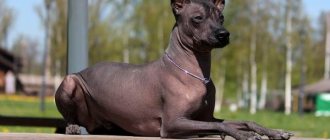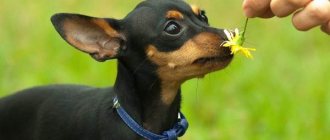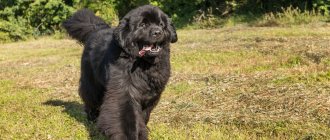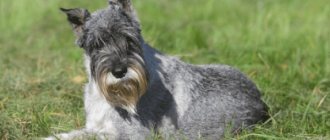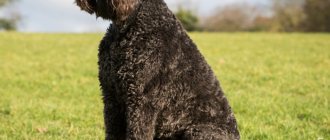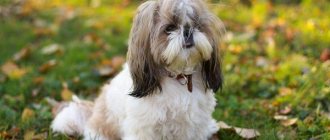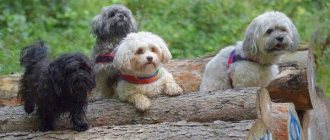Description of the Xoloitzcuintle breed
Popularity 50th place among 263 dog breeds
Lifespan:
12-13 years old
Height:
miniature: 25-35 cm, medium: 36-45 cm, standard: 46-60 cm
Country of origin:
Mexico
Average price:
40-60 thousand rubles
Weight:
miniature: 4-8 kg, medium: 6-10 kg, standard: 9-14 kg
Latest articles Cat health
Rabies vaccination for cats: choice of vaccine, necessity, schedule 01/22/2022 4 0 0
Selection and adaptation
TOP 20 best cat breeds for families with children 01/22/2022 25 0 0
Rare breeds of hairless dogs
Other types of hairless dogs are extremely rare, and little reliable information is known about them:
The African Hairless Dog is a museum exhibit.
- Abyssinian sand terrier. The second name is African Hairless Dog. The breed is registered by only one canine organization - the Continental Kennel Club. Some dog handlers consider it lost. According to other sources, Abyssinian terriers are still bred in the Cape Province in southern Africa.
- Manchurian Hairless Dog. The animals are found in the mountainous regions of China under the name "tai-tai". In appearance and character they resemble Chinese crested cats. Local residents get funny, active dogs “for the soul” and for children’s entertainment.
- Ecuadorian naked. Presumably appeared as a result of spontaneous crossing of Mexican and Peruvian dogs. Animals are bred in the villages of Ecuador. Local residents use them to protect their homes and believe in their healing power. There are no breed kennels.
Ecuadorian hairless dog.
- Hairless Deerhound. Hairless puppies sometimes appear in litters of purebred Scottish greyhounds as a result of a genetic failure. Due to their delicate skin and poor health, they are not suitable for hunting, but they become loyal companions. Breeders reject hairless deerhounds, do not sell them, and do not allow them to be bred. However, there are enthusiasts who defend this branch and fight for recognition.
Hairless Deerhound.
In some publications, the Pharaoh Hound is mistakenly classified as a hairless breed, called the Egyptian Hairless. In fact, they are never born without fur. Animals are covered with very short, tight-fitting hair.
Pharaoh Hound
Read about small dogs with short hair in the article “Smooth-haired breeds of small dogs”
Key facts
This breed has three full varieties: mini, medium and standard. This allows you to have such a dog in any room, be it an apartment in a high-rise building, or a private country house.
However, it is still not worth having a hairless Mexican dog in a cramped apartment. These animals are excellent guards who will start barking as soon as someone enters the entrance. Get ready for spontaneous nightly concerts by your protector.
It is strictly forbidden to have a Xoloitzcuintle in a family with a small child. These dogs are extremely unpredictable around children and can easily bite or injure him.
A special characteristic of the Xoloitzcuintle breed is that one litter can produce both completely hairless puppies and babies with short, coarse hair. This is not considered a deviation. The standards-based description of the Xoloitzcuintle breed recognizes this as an interesting feature.
Although Xoloitzcuintles love all family members and pets, they recognize only one person as their owner for their entire lives.
You need to walk a lot and for a long time with your Xolo. But these animals can’t handle the cold, so on particularly cold winter days it’s better to just go to the nearest park.
Raising a Mexican requires creativity. Standard methods have almost no effect on them, so for each lesson you will have to come up with something new. These must be positive, encouraging methods, otherwise the dog’s interest in training will disappear completely.
You need to treat the Xoloitzcuintle as a full member of the family, and not as a creature that does not understand anything. With the wrong attitude, the life of these dogs turns into real hell. Good attitude and care can make the Xoloitzcuintle's life expectancy very long.
Mexican Xoloitzcuintle mini: sizes, photos
According to canine requirements, this unusual breed comes in different sizes: mini, medium and standard. The most popular is the mini standard, since its miniature dimensions - from 25 to 35 cm - allow you to take it with you everywhere. Here is a photo of this dog:
Xoloitzcuintle Xoloitzcuintle Xoloitzcuintle
Xoloitzcuintle
- Mexican Xoloitzcuintle bitches differ from cables in their size. They are slightly smaller, which is due to their reproductive functions.
- The Xolo Mini's head is small and wedge-shaped.
- Despite its small size, it has a strong jaw with a tight bite.
- The tongue is usually pinkish, but may also contain black specks, which is typical for this breed.
- The eyes, like those of a large dog, are almond-shaped, the color scheme varies depending on the skin tone.
- The ears are bat-like and stand up when alert.
- The Xolo especially attracts attention with its graceful and graceful neck.
- Proportion and flexibility are emphasized by strong muscles.
When touched, the skin feels warm, smooth and soft, which requires additional care in the summer due to the lack of natural protection. Due to the lack of hair, this breed, even in extreme heat, occasionally breathes through its mouth, and sweat occurs through its paws.
History of the origin of the Xoloitzcuintle
It is unlikely that you will be able to find a dog as special as the Xoloitzcuintle. This breed was formed not due to crossbreeding, like most others, but due to a genetic mutation, due to which these animals were left without hair. This deviation was not only fixed in the genome, but also became the real distinctive feature of this breed.
Hairless dogs turned out to be much more adapted to the hot Mexican climate than their relatives with fur, which gradually disappeared. In addition, ticks were much less likely to land on bald ones, and fleas were not interested in them.
After some time, the unusual appearance of the Xolo attracted the attention of the local Aztec tribes. It is from them that the name of the Xoloitzcuintle breed comes. Xolotl is the Aztec god of the underworld, who not only accompanied the sun across the sky, but also controlled thunder and lightning. This god was depicted as a man with the head of a dog.
Compared to other dogs, Mexicans look quite creepy, so it is not surprising that the Aztecs mistook this creature for the companion of God, who accompanied the dead to the afterlife kingdom of Mictlan. According to Aztec myths, on the way there the soul encountered a number of obstacles that could not be overcome without the help of a helper dog.
The Xoloitzcuintli was so exalted that archaeologists still find clay figurines in the shape of animals and their mummies. The oldest of them date back to the fifth millennium BC, making this breed one of the oldest in world history.
The Aztecs believed that this breed truly had divine powers, and strictly followed the instructions of the priests. When a tribal warrior died, the main bloody ritual was to kill his dog, so that on the way to the afterlife it would help him along his path. The owner's arrow was placed into the mouth of the dead xolo, after which both bodies were either buried or mummified. Many such graves have already been found in Mexico and the southern states of the United States.
Some tribes kept the Xoloitzcuintle for completely different purposes. According to the writings, they ate them. In addition, dog meat was considered a real delicacy, which was served only on major holidays. The Aztecs believed that these kinds of feasts paid tribute to the gods and expressed their respect to them, and also that dog meat could endow the chosen ones with the gift of providence. Men ate dogs because it was believed that this would strengthen their virility and gain superiority over other members of their sex.
Xoloitzcuintles could also cure diseases of the Aztecs. However, there is a completely reasonable explanation for this. The dogs' skin is quite hot, the warming effect reduced pain and discomfort from wounds. In the remote villages of Mexico this myth is still alive. There animals are treated for sore joints, internal organs and many other diseases.
The era of the conquistadors was a turning point in the history of the breed. The newcomers tried their best to accustom the Aztec tribes to their ways, in particular, to abandon their rituals and join the European religion. Xolos have become a symbol of times gone by. Dogs were exterminated, fed on them, or bred as livestock. Already by the 16th century, the breed hardly numbered several hundred individuals. Only in mountain villages in Mexico did they manage to escape a harsh fate.
The world heard about the Xoloitzcuintli again only in the 19th century. However, even then the dog was perceived only as a raw material for making things from genuine leather. Only by the middle of the same century the situation changed.
Art critics noticed the Xolos and did everything to save them from persecution. Enthusiasts even assembled an expedition to Mexico, where large populations of the breed were still preserved in villages. The American Kennel Club (AKC) officially recognized the Xoloitzcuintle breed in 1887 and even registered the first dog, a female named Mi Too.
After this, the hype around the breed died down, and they forgot about it. Even the victory of a representative of the breed at the international exhibition in 1940 did not help increase its popularity. Soon the AKC also deleted the breed from its registries. The number of dogs has decreased, and dog owners have almost stopped attending exhibitions and competitions. The breed was saved from complete extinction by lovers of unusual animals, who took it into their own hands to restore the Xoloitzcuintle to its status.
However, the name of only one of them is officially documented - Norman Pelham Wright. In 1954, he went on a trip to Mexican villages with the goal of buying as many dogs as possible from the locals. And he managed to buy more than a dozen animals, after which he began to closely study them.
Soon, “The Xolo Mystery” was published, where he described the breed in detail and formed the first standards for it. Wright's work bore fruit, and already in 1956, bald Mexicans were recognized in their homeland.
The first Mexican dog appeared in Russia shortly before this - in 1940. However, this event went almost unnoticed. And in Europe, Mexico and the USA, clubs for breed lovers were already being formed in full swing. Their participants urged people not to use Xolos as game or raw materials, but to respect them in the same way as other, more famous breeds.
This activity did not go unnoticed. The Xoloitzcuintle was recognized as a national treasure of Mexico, and the number of the breed quickly exceeded 30 thousand individuals. For a breed that almost disappeared from the face of the earth twice, these were incredibly high figures.
A Brief History of Hairless Dogs
Hairless dogs have been living alongside humans since the 5th – 3rd millennium BC. e. They appeared spontaneously in different parts of the world in areas with hot climates: Africa, Asia, Central America. There is no consensus in the canine community about the origin of hairless dogs.
Mexican hairless dog
Presumably the first individuals arose as a result of a random genetic mutation. Then this trait was fixed in the course of natural selection: the less wool, the better the animals tolerated the heat.
Despite its three-thousand-year history, the selection of hairless dogs began only in the 20th century. Now there are less than a dozen breeds of hairless dogs on the planet. Only 3 have received worldwide recognition: Chinese Crested, Mexican and Peruvian Hairless dogs.
Another one, American hairless terriers, is still developing. It is not allowed for breeding in all countries. The rest remain rare and unrecognized.
There is still no consensus on which breed appeared first, how they arose - from one species or each independently. In Russia, they learned about hairless dogs in the 90s. The first club opened in 1996 and united 3 breeds of hairless dogs: Mexican, Chinese Crested and Peruvian.
Appearance of the Xoloitzcuintle
General impression
There are three types of Xolos, each of which has its own height and weight standards. The smallest of them is the miniature Xoloitzcuintle, only 25-35 cm high and weighing from 4 to 8 kg. The average dog grows to 36-45 cm at the withers and already weighs 6-10 kg. Well, large individuals can grow from 46 to 60 cm with a weight of 9 to 14 kg.
The ancestors of modern representatives of the breed belonged to the latter type. This is how they easily survived in the wilds of Mexico, which smaller dogs could not do. In the photo of the Xoloitzcuintle it is noticeable that the females are significantly different from the males. They look more graceful.
Head
The Xoloitzcuintle breed is characterized by a high-set head. It is comparable in size to the body of a dog. The skull resembles that of a wolf: graceful but strong, tapering towards the nose. There is a protrusion on the back of the head. The line of the forehead and nose are parallel.
Muzzle with smooth outlines. There is a little protrusion under the eyes, the cheeks are completely flat. The stop is almost not pronounced. The color of the nose depends on the main color of the dog. Dark-skinned Xolos have almost black noses, while golden or bronze animals may have a flesh-colored or coffee-colored nose. In spotted representatives it may be partially pigmented. The jowls do not droop, the cheeks fit tightly to the jaws. There may be a few wrinkles.
The ears are set high and are quite large. Standing. In this way the dog resembles a bat. The ears are soft and pliable to the touch.
Almond-shaped eyes. Their color depends on the color of the dog. Typically varies from black to golden yellow. The eyelids have a grey, brown or black edging. The look is attentive, wary.
Scissor bite, teeth close together. It is not necessary to have a full set of teeth. Although furred Xolos are rare, their teeth are much stronger than those of their hairless counterparts.
Neck
The graceful, not too muscular neck of the Xoloitzcuintle is set quite high. It widens towards the base and smoothly passes into the withers. In adult dogs, the skin on the neck is dense and fits well to the body; in puppies, folds are acceptable.
Torso
The body is slightly stretched. Its length is 10% greater than the height of the animal. The chest is narrow, reaching down to the elbows. The back is straight, but short. The shoulder blades are sloping and strong. Muscles are visible on the lower back, creating a slight bulge. The croup looks down at an angle of 40 degrees. The belly is tucked in.
Forelegs
Paws are dry, joint angles are balanced. The elbows are pressed tightly to the chest. The pasterns are set at an angle, the forearms are straight. The paws may sometimes be covered with short hair. The color of the claws depends on the base color. It happens that Xolo puppies are born with extra toes. They must be removed no later than 7 days after birth.
Hind limbs
A dog's hind legs are much more muscular than its front legs. This is indicated by voluminous hips. The hock joints are directed parallel to the dog's body. The dog's paws are more like a hare's, the toes are gathered into a ball, the pads are rough and elastic. The 5th finger is also removed in the first week of life.
Movement
Xolo walks quickly. Compared to other four-legged animals, this breed seems to be always late for somewhere and moves at a fast, but not mincing, trot. However, even this pace does not prevent her from keeping her back straight and her head high. When accelerating, the powerful hind legs are able to provide a good push, and the dog literally takes off.
Wool
Mexican hairless dogs are called hairless because they have no hair at all. However, there are exceptions. Some puppies are born with a forehead and scruff of the neck covered in tough, short hair. Usually the length of this wool does not exceed 2.5 cm.
Color
Most dogs of this breed have a solid color throughout their entire body, and Xoloitzcuintle colors can range from bluish-gray to black. There are also light dogs with golden, reddish or bronze coloring. The presence of points is acceptable, but not more than 25% of the entire body surface.
Size
The sizes of the Xoloitzcuintle are divided into three types:
- miniature – 25-35 cm, 4-8 kg;
- medium – 36-45 cm, 6-10 kg;
- standard – 46-60 cm, 9-14 kg.
Size and variety do not affect the character and temperament of animals. The height of a Xoloitzcuintle can exceed 60 cm, but the dog will not look too massive. The Xoloitzcuintle's weight should correspond to his height; obesity or excessive thinness should not be allowed.
Xoloitzcuintle dogs: price of puppies in Russia
Xoloitzcuintle
The Mexican hairless dog Xoloitzcuintle captivates many with its unusualness. How much do puppies of this breed cost in Russia?
- Often the price depends on the “noble” blood and titles of the parents, the requirements of the breeder or online seller.
- Naturally, puppies with a pedigree from specialized foreign nurseries will cost much more than a representative of the breed without documents purchased through an advertisement.
- On average, the price for a xoloitzcuintle is 40-50 thousand rubles . Although there are cheaper options - about 3 thousand . But there is no guarantee that a puppy purchased “on occasion” will have the appropriate appearance.
It is worth remembering: There is a mini-version of this breed (read above in the text). This does not affect the price in any way, but it can be confusing when purchasing.
Starting from 30,000 rubles, you can count on a pet that has all the necessary documents (metrics, veterinary passport), as well as a brand and a microchip. Although, if a representative of this breed is purchased not for exhibitions, but for friendship, it is also quite possible to choose a cheaper option.
Character of the Xoloitzcuintle
The character of the Xoloitzcuintle is quite friendly and balanced. However, no one deprived them of their temperament. At a young age, puppies are playful and active. With age, they calm down and behave much more dignified. In the company of people, they try to behave quietly and are happy to make friends with guests, of course, after barking at them a little first.
Xolos are very attached to the people with whom they have lived most of their lives, so giving or selling such a dog as an adult will not work. And for a dog to grow up sociable, all family members must take part in its upbringing. Don't worry, she knows perfectly well who her owner is and will always be able to pick him out from the crowd.
If the Xolo recognizes you as the owner, you are a winner, because now you have a loyal and reliable friend for a long time. The dog will always be by your side and will not miss a single event in your life. True, sometimes this breed can be a little intrusive, but you should not deny it play or hugs, because it, like any family member, needs your attention. Skin contact is very important for these animals. Spend more time with your pet and it will make him happy.
There are differing opinions about how these dogs get along with children. But if you are looking for a friend for your child, you probably shouldn’t consider a Xolo. This breed is more suitable for families with older children who no longer torture animals and know how to handle them.
Xoloitzcuintles also get along with other pets. This applies to both dogs and cats. They don’t really like to fight, but if we are talking about protecting their own territory, then they can stand up for themselves. But in relation to other people's animals, Xolos show extreme intolerance. Therefore, you should not take them to dog parks and be sure to keep them on a leash while walking.
Where are the Xoloitzcuintle nurseries located?
Xoloitzcuintle
The Xolo breed requires a careful approach to choosing a puppy. In order to choose the right purebred pet, you need to contact specialists who are professional breeders and have a veterinary or canine education. They will competently talk about this breed, habits, health, character and lifestyle.
Kinich Ahau nursery is one of the best in Russia:
- This organization has all the necessary certificates and is registered with the International Canine Association.
- She has many World and European champions in her collection.
- Pets are winners of major exhibitions and receive excellent reviews from respected experts, demonstrating the beauty and grace of beautiful Xolos.
The RND HAIRLESS nursery is a monobreed and breeds standard size xolos:
- This is a family-type kennel, that is, all dogs live permanently with their owners at home.
- They prepare for each litter very responsibly and thoroughly. All pets must have a full range of vaccinations, branding and specialized documents.
Kennel GRIS MONTENEGRO:
- Engaged in breeding miniature and medium-sized Xolos.
- All dogs have excellent grades and titles, promising for breeding.
- The main goal of the kennel is to produce beautiful, healthy dogs with adequate mental health.
- Dogs and puppies of the kennel successfully perform at exhibitions, including special breed exhibitions, often taking the lead. They are worthy competition among the leading representatives of this ancient breed.
Remember: Choosing a pet is a responsible step, and therefore this procedure should be taken very seriously. A puppy is not a toy; it needs careful care, proper upbringing, health care and responsibility for its life in our world.
Education and training
Mexicans are willful, so education and training should begin from early childhood. Don't let your puppy do anything you wouldn't allow an adult dog to do, but don't scold him either. With the proper skill of the owner, the puppy will quickly understand which actions are approved and which are not. Well, a stern look is perfect as a preventative measure.
If you are a constantly busy person, you should give up the idea of getting a Xolo puppy. Be prepared for the dog to take up absolutely all your time. He cannot be left alone; he needs your attention constantly. If you have a busy schedule, but have another pet, then make sure that they become friends and the baby Xolo does not get bored at home.
Create a favorable atmosphere for the puppy to communicate not only with family members, but also with other people and animals. If desired, the training process can be supplemented with classes with an instructor. Even in winter, do not stop training. With hardening and regular walks, Xolos tolerate frost well.
Key points in training
The breed is not difficult, despite its aboriginal origin . Xolo's abilities are aimed at cooperation with people, oriented towards family and surrounding people. They quickly remember commands and are rarely stubborn, but can be aggressive towards other people or animals. Therefore, your pet needs to be weaned off outbursts of negative emotions and uncontrolled antics.
The direction of training is chosen by the owner. He can contact special canine schools and take his pet through a training course with specialists. The main types of programs: general course (training commands, rules of behavior and relationships with the owner), agility (running with obstacles), freestyle (playing with a flying disc, developing muscles and reaction), flyball (chasing a ball with obstacles).
Read about how to properly train a dog in the article: “Training a puppy: effective methods from dog handlers, learning commands at home.”
They begin to raise puppies from an early age, explaining to them that they cannot go to the toilet at home, damage furniture, beg, or sleep in the owner’s place . The pet should know that a person is always the first to enter the house, and feeding takes place after the whole family has eaten. Training begins from 4 months , when the puppy gets used to the street and goes through the first stages of socialization.
Xoloitzcuintle health and diseases
Possible diseases
Xoloitzcuintles are distinguished by excellent immunity due to their independent consistent development. However, after the work of breeders, common diseases began to appear more and more often, such as:
- tooth loss;
- allergy;
- unhealthy color plaque on the skin;
- sunburn;
- drooping ears (weak cartilage);
- dermatitis.
These dogs suffer from other diseases quite rarely. They quickly adapt to any climate, but at temperatures below -20 degrees they need clothing, otherwise they risk frostbite.
Reproductive health
In general, Xolos are less susceptible to sexual diseases, but to avoid unwanted pregnancy, veterinarians still recommend sterilizing dogs. This can be done after the first heat, which begins in Xolos at the age of 10-12 months and lasts approximately 12-18 days. At this time, take the bitch outside with extreme caution, because she attracts a lot of attention from strangers and stray dogs.
Xoloitzcuintle pregnancy occurs without complications, as does childbirth, if the dog was more than 2.5 years old at the time of pregnancy. Early pregnancy has a bad effect on both the health of the bitch and her subsequent litters. Take your time with breeding, and be sure to consult a veterinarian before breeding.
Mating
As with all dogs, there are optimal times for mating for Xolos. It is important to know that pets cannot be reduced until their 3rd heat, approximately 2-2.5 years. Males are allowed to breed at 25-30 months . By this age, animals are fully formed and can conceive and give birth to healthy offspring.
After the female starts estrus, you need to count 10-13 days. This period of time is ovulation. Then the girl appears in a playful mood, she accepts the male, the loop increases in size, and the discharge changes its color to light or light yellow.
Mating can be carried out on neutral territory or at the dog’s home. There the boy will feel relaxed. Pets are given 5-10 minutes to get acquainted. After the boy makes the cage, the animals need to be helped to find a comfortable position. Usually the girl is held by the head and under the belly, and the male is guided into the noose.
Read a detailed article on the topic: “Everything you need to know about breeding dogs: appropriate age, what to do if it doesn’t work out, rules and tips.”
The act lasts 10-15 minutes. The ideal ending would be a castle in which the dogs stand for 5-7 minutes . But pregnancy can happen even without a lock. Repeat mating after 48 hours to be on the safe side. After 2 weeks, the first signs of pregnancy may appear: toxicosis, restlessness, changes in behavior.
Features of feeding and diet
The Xolo bowl should always be at least 2/3 filled with meat. However, you should avoid meats such as beef, pork or chicken. Give preference to rabbit, lamb or turkey. Once a week you can diversify the menu with boneless sea fish. The remaining 1/3 will consist of dairy products, cereals and fresh vegetables.
There are several foods that are unsuitable for Xolos:
- berries with seeds;
- milk;
- raw yeast dough;
- salty, spicy, pickled or sour foods;
- legumes;
- bones in any form.
There should always be clean water in your dog's bowl. If you use tap water, you must first let it sit for at least 12 hours and then boil it.
Nutrition
Unfortunately, Xoloitzcuintles very often suffer from allergies, especially to specific foods. For this reason, experts strongly recommend that owners of such pets not feed them food from their table. At any moment they may experience an adverse reaction in the form of vomiting, rash, etc.
Therefore, the best product for such an animal is dry food. It can be bought in an online store, a zoological salon, and even in a veterinary clinic. A good option is to first consult with the doctor who observed your animal.
Important ! You should not feed your Xoloitzcuintle puppy a grain feed mixture. You should also avoid products that contain dyes or food additives.
If an animal has dental problems, it is recommended to give it soft dry food. It is also commercially available. Feeding it with cereals, meat or berries is prohibited.
Your pet may develop a food allergy if they eat the following foods:
- Pasta.
- Dishes prepared with a lot of spices.
- Honey.
- Delicious baked goods.
- Canned meat.
Care and maintenance
Xoloitzcuintles require very minimal care. Their lack of fur immediately solves many problems, such as washing or combing. Even for dogs born with fur, this is not a problem, because it is enough to simply comb out the dead hair with a special mitten once every one or two weeks.
Once every two weeks, the Xolo should be washed with gentle products. Regular dog shampoo can dry out and damage the skin. If necessary, just rinse your dog with warm water. Well, to prevent her from catching a cold, dry her thoroughly with a towel and do not let her out into drafts.
Often Xolo owners are faced with a problem such as acne. They look like little black dots. This is normal for puppies. Getting rid of them is quite easy with the help of special scrubs and lotions. If they appear on the body of an adult dog, this is a reason to consult a doctor, because allergies or vitamin deficiency may manifest themselves this way.
Sunburn is the main summer problem for Xoloitzcuintles. Before going for a walk, apply sunscreen to your dog's body, and be sure to wash it off in the shower when you return. In general, the maintenance and care of the Xoloitzcuintle is limited to careful attention to its skin, ears and teeth.
Peruvian hairless dog
Early depictions of hairless dogs at archaeological sites in Peru date back to the 3rd century BC. Other names - moon flower, Inca orchid - were given to representatives of the breed later, during the heyday of the Inca civilization. Back then, hairless dogs were treated with reverence and were credited with the ability to give people positive energy and cure illnesses.
Peruvian Inca Orchid
The fate of Peruvian hairless dogs resembles the history of Mexican ones. In Peru, dogs without hair were considered defective. By the 19th century, the breed had almost disappeared, but there were enthusiasts. They opened a shelter for stray hairless dogs, then the state stood up to protect the animals.
In 1984, Peruvian dogs were approved by the International Canine Organization, and in 2001 they became the national treasure of Peru. The breed remains rare, with no more than 1 thousand individuals registered in the world. It is illegal to export miniature hairless dogs from Peru.
Tips for choosing a puppy
Mexican Hairless dogs are a fairly rare breed, so it is difficult to find breeders who specialize in breeding. However, you should not buy a puppy from the first one you come across. A good breeder will not only tell you about caring for the animal, but will also help you choose a baby based on your own goals.
The breeder must answer all the questions you ask him, show you all the documents and introduce you to the parents of the litter. It is important to pay attention to the conditions in which dogs are kept. If the owner does not let them out of the enclosure or cage, this is a bad sign.
Xoloitzcuintle puppies must be clean, well-groomed, moderately well-fed, and they must always have access to water and their mother. The enclosure should not smell bad or have too much feces.
There is no point in focusing on the appearance of dogs. Of course, he is not very attractive to them at a young age. The whole body is in folds, the muzzle is short, the plump body is on short clubbed legs. This shouldn't put you off. The main thing in a Xolo is its character, which manifests itself from the first weeks of life.
How to choose a puppy
Mexican Hairless dogs are a rare breed, so the number of kennels that specialize in breeding them is limited. It is still worth spending time searching for a breeder. He will help you choose a Xoloitzcuintle for various purposes: participation in exhibitions, breeding, or for warm (in every sense) communication.
Pay attention to how the breeder answers your questions, whether he is ready to confirm his reputation and show the necessary documents, and whether he is interested in the future fate of his charges. At the same time, pay attention to the living conditions of the dogs. Animals must be well-groomed, enclosures must be cleaned, bowls must always be filled. The absence of drafts is a must, otherwise you risk getting a cold puppy.
After that, start meeting your potential friend's parents. It is necessary to observe the behavior of the bitch and the dog, assess their character and state of health. It would also be useful to ask the breeder to present documentation confirming the absence of genetic diseases.
Sometimes in one litter several varieties of Xolo are born: standard, medium and miniature. Because of this feature, it is quite difficult to choose a puppy for further participation in exhibitions, since it will not be possible to predict its size. This can only be done by those who breed the breed and watch the dogs for a long time. If you are interested in a show-class Xoloitzcuintle, ask the breeder to point out potential candidates.
The appearance of babies can be repulsive: plumpness, numerous folds on the body, short and clumsy legs, a blunt muzzle... However, when choosing a puppy, you should not focus solely on this: Xolos grow into graceful dogs with smooth skin and light, elongated legs. Look for a friend by character - and you won’t go wrong!
Pay attention to playful and curious kids who are not afraid to approach a stranger. In this case, it is best to choose a puppy who shows moderate activity: does not bully his relatives, but does not cower cowardly in the corner. Xoloitzcuintles inherit their temperament from their parents, so a couple of minutes of communication with a female or male dog will help you understand how easily you will get along with a puppy. Gender does not matter, because all dogs show amazing devotion to their owner.
